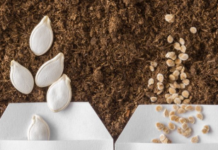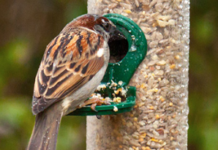https://hnr.k-state.edu/extension/info-center/newsletters/index.html
Blog Post: http://www.ksuhortnewsletter.org
Video of the Week: Stake and Weave Tomatoes
https://kansashealthyyards.org/all-videos/video/stake-and-weave-tomatoes
REMINDERS
• Mound soil around potato plants to make sure tubers aren’t exposed. Sunlight hitting tubers will cause them to turn green.
• Check fruit trees for fruit. Multiple frost events this spring may have eliminated fruit on apricots, peaches and plums but some made it through. Apples and pears may have been thinned but should bear a good crop through much of the state. If no fruit, sprays may not be needed except for the leaf disease on apples such as cedar-apple rust, apple scab and powdery mildew.
VEGETABLES
Cabbage Worms
The imported cabbage worm is making its appearance this time of year. White eggs are laid by white butterflies and hatch into fuzzy green worms. If not controlled early, managing this pest is much more involved and plant injury can be extensive.
Organic treatments for cabbage worms include: BT (Bacillus thuringiensis) (Dipel, Thuricide and others) and Spinosad (Monterey Garden Insect Spray, Captain Jack’s Dead Bug Brew). If using BT, apply it late in the day or on a cloudy day; the pesticide’s efficacy is affected by sun exposure. (Cynthia Domenghini)
‘Staggering’ Sweet Corn Planting
Since the flavor of fresh corn only lasts for a few days, you may choose to do repeated plantings to stagger the harvest dates. Spreading out the harvest throughout the season prevents a surplus of corn that you may have with a single planting date. Rather than following a set calendar schedule of planting dates, delay the second planting until the first round has reach 1/2-inch to 1-inch tall. Continue repeated plantings following this protocol. (Cynthia Domenghini)
Make Tomato Cages
Concrete reinforcing mesh (wire) can be used to make stronger tomato cages that can endure large, productive tomato plants and Kansas growing conditions. The mesh is typically sold in 50-foot-long rolls that are 5-feet high. The mesh has 6-inch squares that accommodate access to the tomato plants for harvest, inspection or other care. Each cage should be about 2-feet in diameter for proper containment. Cutting the mesh into 6 ½ – foot lengths will provide an adequate diameter after assembly.
Roll the mesh onto the ground and count 13 squares. Using small bolt or standard wire cutters, cut the wire at the end of the thirteenth square leaving intact12 squares. Allow the mesh to form a cylinder and wrap the cut pieces of the final squares around the first squares to hold the shape. Adjust the height of the cage by cutting entire squares, if desired, depending on the type of tomatoes you are growing.
Cut the wire at the base of the cylinder to create prongs that can extend into the ground when placed around the tomato plant. This will provide some security for the cage. For additional support, drive a T-post into the ground next to the cage and tie the cage to it.
These sturdy cages will last multiple years but are bulky and require extra storage space. Cages that fold flat or can be disassembled are available from Texas Tomato Cages, Titan Tomato Cages and other sources. These can be costly and will still require staking if you grow in a windy area. (Cynthia Domenghini)
FRUIT
Peach Leaf Curl and Plum Pocket
The fungal disease, peach leaf curl, presents as reddish areas on developing leaves that begin to pucker causing distortion and leaf curling. Leaves later turn yellow or brown and may fall prematurely. Plant energy is used to produce a second set of leaves and in severe cases can significantly inhibit fruit production and overall tree growth. Maintaining healthy trees is the best protocol against peach leaf curl. Large, deep green leaves and 18-24-inches of growth from the previous year indicate a healthy tree. If you observe your tree had less than 12-inches of growth, fertilizer should be applied.
Apply 1-1/3 to 2 cups of a 13-13-13 fertilizer on the soil under the tree canopy. You can substitute a high nitrogen fertilizer (27-3-4, 30-5-4 or similar) at a rate of 1/6 to ¾ cups to the ground below the branching area. If only nitrogen is needed, use 1/3 to 1-1/2 cups of nitrate of soda (16-0-0) instead. Apply fertilizer as soon as possible to quickly promote leaf growth. Selectively removing developing fruit can also help infected trees direct energy to growth.
Plum pocket is a similar disease that occurs on American and sand hill plum trees. Though not fatal to the plant, fruit from infected plum trees is distorted, light green-greyish in color and bladder-shaped. Seeds of infected fruits do not develop and leave a hollow plum or a “pocket”. Asian and European plums are not susceptible to plum pocket.
Applying fungicide to peach and plum trees in the fall after leaves have dropped can be an effective control against these diseases. The fungicide chlorothalonil (Bravo, Daconil, Fertilome Broad-Spectrum Fungicide) can be applied to the entire tree including the bark and trunk to ward off infection in the spring. (Cynthia Domenghini)
MISCELLANEOUS
Rabbits in the Garden
Rabbits can cause trouble in the garden year-round due to their appetite for a great variety of crops. As young plants emerge and develop this time of year, rabbits are feasting. Potatoes, tomatoes, corn, squash, cucumbers and certain pepper types are not favored by rabbits but more susceptible plants can be protected.
Fencing the area with two-foot high, fine mesh (1-inch or smaller) can effectively keep out rabbits. Use stakes or electric fence posts to support the mesh.
Floating row covers are typically a solution for getting a jumpstart on the growing season by creating a warmer microclimate around the planter beds. It can also serve as a protection from insects and wildlife. Choose a lightweight, white fabric such as polyester for row covers to be used for pest exclusion. Monitor the temperature underneath the cover and remove it if the temperature climbs above 90 degrees F.
Repellants, trapping and shooting are other controls sometimes used by gardeners. Repellents typically require frequent reapplications for best control and may be poisonous making them unsafe to use on plants for human consumption. Live traps can be used to capture rabbits and relocate them to another location several miles away. Getting rabbits to enter the trap can be tricky considering the buffet of food available in the garden, but using a tightly rolled cabbage leaf held closed with a toothpick can work. If safe and legal, shooting can also be effective.
Motion-activated sprinklers can scare off predators. Attached to the garden hose, the sprinkler releases short bursts of water when motion is detected. Contech, Orbit and Havahart are suppliers that advertise protecting up to 1,000 square feet. (Cynthia Domenghini)
Moving Houseplants Outside for the Summer
When the night temperature outdoors stays above 55 degrees F, it is safe to move houseplants out for the summer. Place plants in an area of dappled shade that is protected from the wind. After spending months indoors under low-light conditions, exposure to direct sunlight can cause leaves to sunburn (photooxidize). Burying the base of the pot in soil will help moderate the root temperature and reduce watering needs. (Cynthia Domenghini)
Contributors:
Cynthia Domenghini,. Instructor ([email protected])
Ward Upham, Extension Associate ([email protected])
Division of Horticulture
1712 Claflin, 2021 Throckmorton
Manhattan, KS 66506
(785) 532-6173
For questions or further information, contact: [email protected] OR [email protected]
This newsletter is also available on the World Wide Web at: http://hnr.k-state.edu/extension/info-center/newsletters/index.html
The web version includes color images that illustrate subjects discussed. To subscribe to this newsletter electronically, send an e-mail message to [email protected] or [email protected] listing your e-mail address in the message.
Brand names appearing in this newsletter are for product identification purposes only. No endorsement is intended, nor is criticism implied of similar products not mentioned.
K-State Research and Extension is committed to making its services, activities and programs accessible to all participants. If you have special requirements due to a physical, vision or hearing disability, or a dietary restriction please contact Extension Horticulture at (785) 532-6173.
Kansas State University Agricultural Experiment Station and Cooperative Extension Service K-State Research and Extension is an equal opportunity employer. Issued in furtherance of Cooperative Extension Work, Acts of May 8 and June 30, 1914, as amended. Kansas State University, County Extension Councils, and United States Department of Agriculture
Cooperating, Ernie Minton, Dean.





